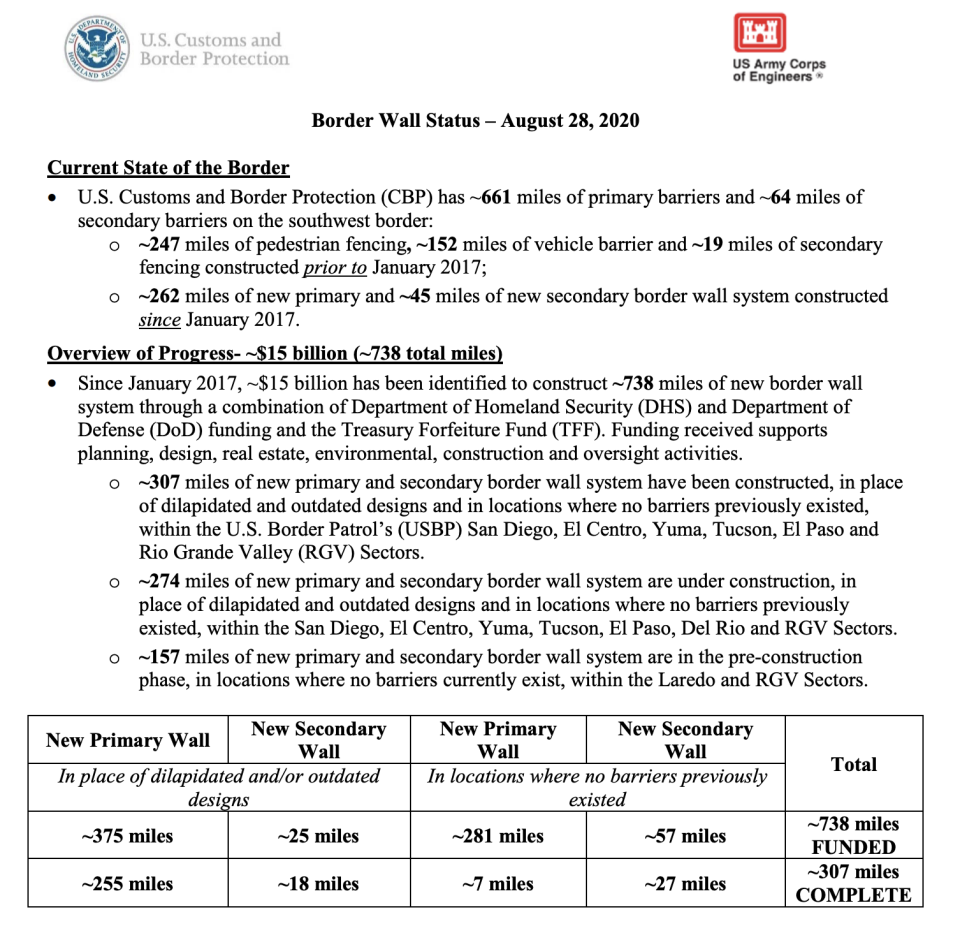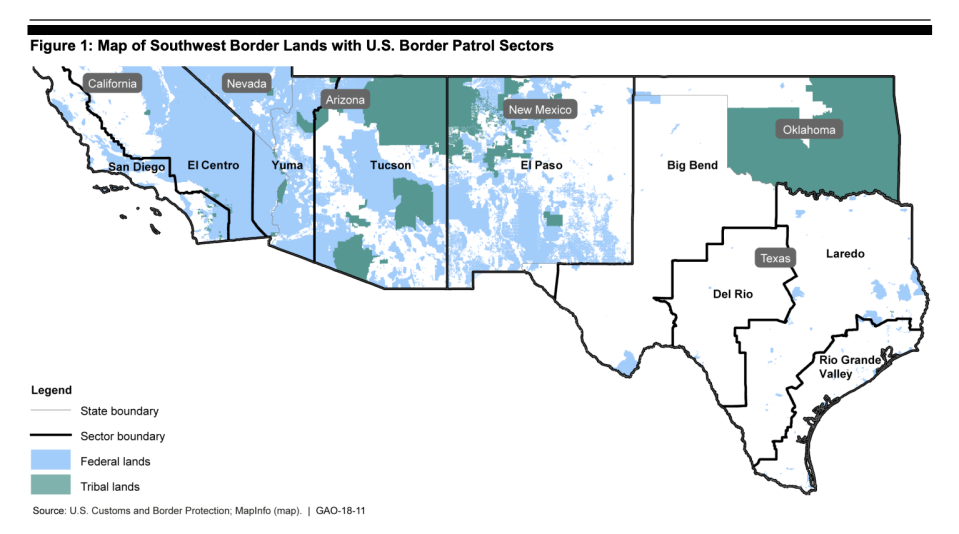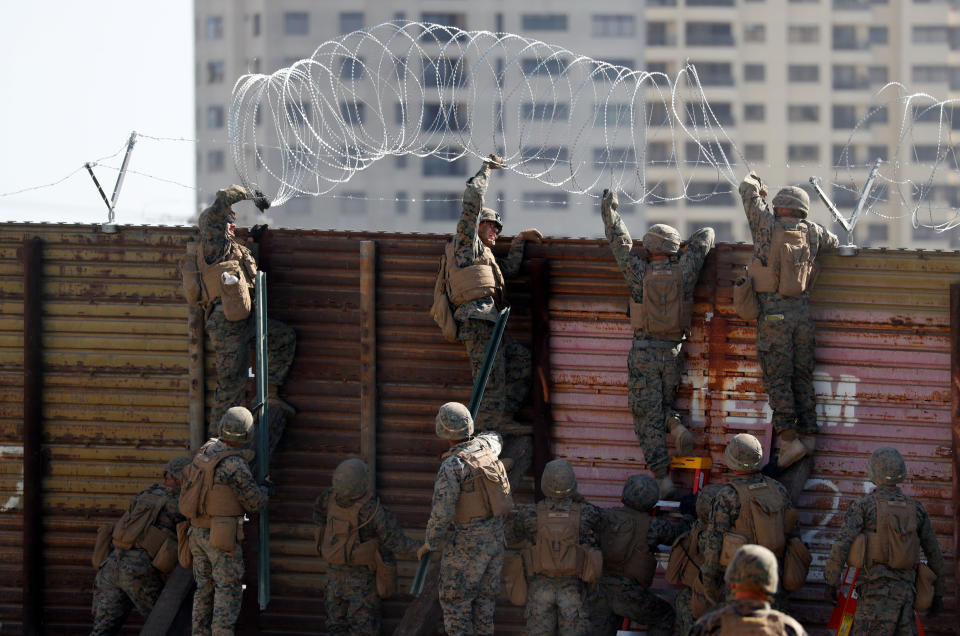Former border commissioner: President Trump's 'incredibly expensive' border policy didn't make sense in first place
President Trump’s border “wall” — which is actually a combination of vehicle barriers and pedestrian fencing — has come at a hefty price so far.
More than $15 billion has been allocated during the Trump administration to build roughly 738 miles of a new "border wall system,” according to the latest update from the Customs and Border Patrol (CBP), though most of that has not actually been constructed.
In any case, former CBP Commissioner Gil Kerlikowske believes that the money going toward Trump’s wall could be better spent.
“The money is much better invested in technology than barriers,” Kerlikowske told Yahoo Finance. “And remember, the cost of the barrier, which you’ve seen some prices that are multi-millions of dollars per square mile or per mile of barrier. The other part is that all of this, since the Secure Fence Act and since these things have been installed over several administrations, is the cost of maintenance and repair.”

Sarah Pierce, a policy analyst at the Migration Policy Institute, agreed that there are better and more efficient ways to monitor the border.
“Technology would be a good investment,” Pierce told Yahoo Finance. “A lot of the times when people are talking about our systems along the southern border, and the degree of security we have, they talk about operational awareness. And the fact that we don't have operational awareness along the whole border, so we know how many people are coming across the southern border. But investments in technology could help us know that and that's a pretty important thing to know when you're talking about security of a border if you're concerned about it being very porous.”
‘The most expensive wall in the world by far’
In an August 28 update, CBP states that approximately 255 miles of a primary border wall system (with 18 miles of a secondary wall system) has been built to replace outdated and/or dilapidated designs during the Trump administration. (Only about seven miles of entirely new primary walls and 27 miles of secondary walls have been constructed in places where border wall construction previously didn’t exist.)

How much progress President Trump can make in the last few months of 2020 is unclear, though thing is clear: Construction has been an expensive slog.
“The current U.S. border wall project is the most expensive wall in the world by far,” Reece Jones, a professor and chair of the University of Hawai’i at Manoa’s Department of Geography and Environment, told Yahoo Finance, noting that the barriers being built in Israel are a fraction of the cost.
Approximately 78 miles of new border wall construction was expected take place in the Fiscal Year 2018, but only about 52 miles have been completed to date. Similarly, nearly $2 billion was allocated for approximately 85 miles of new border barriers for 2019, but only three miles have been constructed so far.

In February 2019, the government was shut down for 35 days after Congress and Trump couldn’t come to an agreement over a budget for the border.
More than $1.38 billion has been allocated for border wall construction for the Fiscal Year 2020, according to CBP data, which Kerlikowske described as “really significant.”
“You have flooding, you have other kinds of damage, people, of course, cutting them,” he said. “So people shouldn’t look at this just as the cost of this fixed wall or barrier. They should look at the long-term costs. They are going to be replaced over the years, plus maintenance costs, so it’s incredibly expensive.”

The current system, Pierce noted, cannot handle the overwhelming flow of migrants crossing the border.
“The unprecedented numbers that we saw during the Trump administration were families and unaccompanied children,” Pierce said. “And the systems that we have in place at the southern border are still enforcement first, they're still designed to detect and detain the population we saw more so in the early 2000s.”
So “single adults who are trying to sneak across the border, the resources at the southern border are not sufficient to meet the population that is coming,” she added. “We do not have facilities to have children. We don't have facilities that are sufficient for families so there needs to be big and quick investments in really restructuring to meet the current reality… We need a system that can be flexible to address humanitarian flows, and also a system that will do a good job of detecting people trying to come across undetected.”

‘Walls are not effective’
The idea for a border wall did not come from Trump, but rather former President George W. Bush through the Secure Fence Act, which was passed back in 2006.
This called for 700 miles of at least two layers of reinforced fencing on the border, in addition to “the installation of additional physical barriers, roads, lighting, cameras and sensors” in California, Arizona, New Mexico, and Texas. (The Trump-era CBP’s stated aim is to extend the wall to roughly 1,000 miles.)
Through the Secure Fence Act, however, “the barriers would often then send people to try and cross in other areas, either areas that essentially were more dangerous or areas where the Border Patrol could more easily make an apprehension, but the barriers haven’t proven to be particularly effective,” Kerlikowske said. “And of course, McAllen Texas is the area, the Rio Grande Valley is where the vast majority of the people were going through, and that’s also the place that’s absolutely without question the most difficult place to build a barrier because of the environment.”

Several experts, including Jones, have agreed that a wall along the border is not efficient in stopping the flow of illegal immigration.
“Scholars have repeatedly demonstrated that walls are not effective at preventing movement at a border, particularly at very long borders like the U.S.-Mexico boundary,” Jones said. “Instead, border walls function primarily as a symbol of exclusion and are used by nationalist politicians to demonstrate action to their base of supporters.”
On top of that is the cost to taxpayers, despite the fact that back in 2016, then-candidate Trump promised that "Mexico will pay for the wall - 100%!” He also asserted that his wall “is going to be a real wall, it’s going to be a high wall, it’s going to be a beautiful wall,” and it would cost “maybe $10 or $12 billion dollars.”
President Trump’s border wall policy turned out to be more expensive and funded by American taxpayers.
“I think they’ve approached this not in a very meaningful way,” Kerlikowske said. “Whenever somebody gives you a quick and simple answer to a really complex problem like immigration and says, ‘Build a wall,’ rest assured you can pretty well be assured of one thing, and that is that it’s not going to work. It’s a false statement.”
Adriana is a reporter and editor for Yahoo Finance. She can be reached at adriana@yahoofinance.com. Follow her on Twitter @adrianambells.
READ MORE:
Trump's drug czar makes case for border wall being 'a force multiplier'
'A fight at every step': Trump's wall will have to battle the people who live there
Scaramucci: Trump is ‘doubling and tripling down on full-on racism’
Read the latest financial and business news from Yahoo Finance
Follow Yahoo Finance on Twitter, Facebook, Instagram, Flipboard, SmartNews, LinkedIn, YouTube, and reddit.


